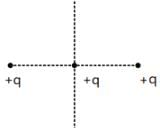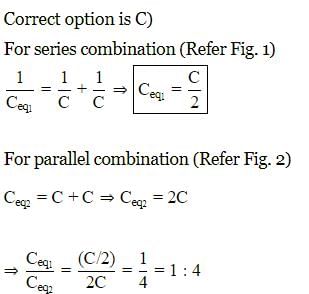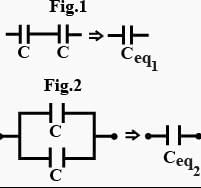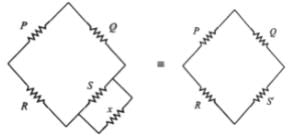Physics: Topic-wise Test- 4 - NEET MCQ
30 Questions MCQ Test - Physics: Topic-wise Test- 4
Mid way between the two equal and similar charges, we placed the third equal and similar charge. Which of the following statements is correct, concerned to the equilibrium along the line joining the charges ?
Two fixed charges 4Q (positive) and Q (negative) are located at A and B, the distance AB being 3 m.
Select the correct statement : (Only force on a particle is due to electric field)
Consider a conductor with a spherical cavity in it. A point charge q0 is placed at the centre of cavity and a point charge Q is placed outside conductor.
Statement-1 : Total charge induced on cavity wall is equal and opposite to the charge inside.
Statement-2 : If cavity is surrounded by a Gaussian surface, where all parts of Gaussian surface are
located inside the conductor,

A particle of mass m and charge q is thrown in a region where uniform gravitational field and electric field are present. The path of particle
Two equal negative charges are fixed at the points [0, a] and [0, –a] on the y-axis. A positive charge Q is released from rest at the points [2a, 0] on the x-axis. The charge Q will -
An electric dipole is placed at an angle of 30o to a non-uniform electric field. The dipole will experience
Two point charges +8q and –2q are located at x = 0 and x = L respectively. The location of a point onthe x axis at which the net electric field due to these two point charges is zero is:
Here is a combination of three identical capacitors. If resultant capacitance is 1 μƒ, calculate capacitance of each capacitor.
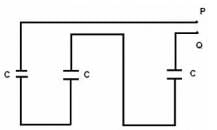
If the potential difference of a 6µF capacitor is changed from 10V to 20V, the increase in energy stored will be
If two spheres of different radii have equal charge, then the potential will be
There are three capacitors with equal capacitance. In series combination, they have a net capacitance of C1 and in parallel combination, a net capacitance of C2.What will be the value of ratio of C1 & C2?
Two capacitors of 20 μƒ and 30 μƒ are connected in series to a battery of 40V. Calculate charge on each capacitor.
Two capacitors of equal capacity are first connected in series and then in parallel. The ratio of the total capacities in the two cases will be
When two capacitors C1 and C2 are connected in series and parallel, their equivalent capacitances comes out to be 3μƒ and 16μƒ respectively. Calculate values of C1 and C2.
The value of electric potential throughout the volume of a conductor is
How does the charge densities of conductors vary on an irregularly shaped conductor?
Two conductors having same type of charges are connected by a conducting wire. There would not be any amount of charges on them if:
Consider a neutral conducting sphere. A positive point charge is placed outside the sphere. The net charge on the sphere is then,
In a wheatstone bridge if the battery and galvanometer are interchanged then the deflection in galvanometer will
In a Wheatstone’s network, P = 2Ω, Q = 2Ω, R = 2Ω and S = 3Ω. The resistance with which S is to be shunted in order that the bridge may be balanced is
Four resistances of 3Ω, 3Ω, 3Ω and 4Ω respectively are used to form a Wheatstone bridge. The 4Ω resistance is short circuited with a resistance R in order to get bridge balanced. The value of R will be
Resistances P, Q, S and R are arranged in a cyclic order to form a balanced Wheatstone's network. The ratio of power consumed in the branches (P + Q) and (R + S) is
Under what condition current passing through the resistance R can be increased by short circuiting the battery of emf E2. The internal resistances of the two batteries are r1 and r2 respectively.
ABCD is a square where each side is a uniform wire of resistance 1Ω. A point E lies on CD such that if a uniform wire of resistance 1W is connected across AE and constant potential difference is applied across A and C then B and E are equipotential.
Two current elements P and Q have current voltage characteristics as shown below :
Which of the graphs given below represents current voltage characteristics when P and Q are in series.
A battery is of emf E is being charged from a charger such that positive terminal of the battery is connected to terminal A of charger and negative terminal of the battery is connected to terminal B of charger. The internal resistance of the battery is r.
A simple circuit contains an ideal battery and a resistance R. If a second resistor is placed in parallel with the first.


